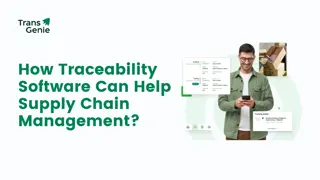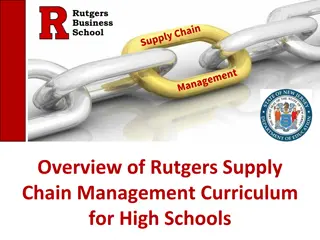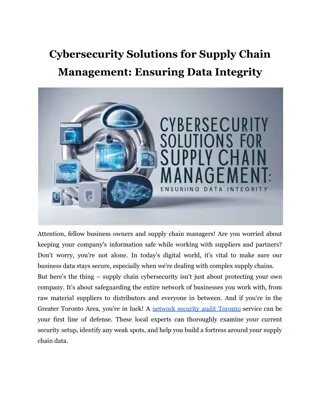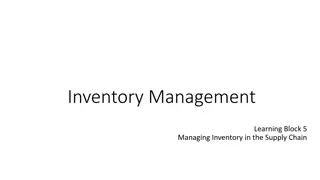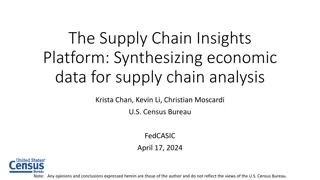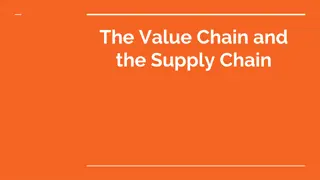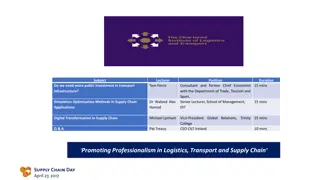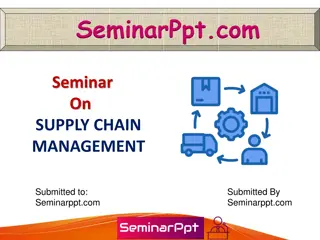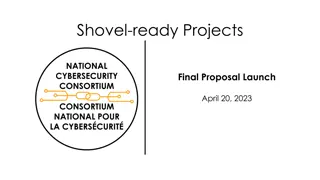Cybersecurity and Supply Chain Risk Management Best Practices
Supply chain attacks pose a significant threat to software developers and suppliers by targeting source codes and build processes to distribute malware. This article discusses the importance of supply chain risk management, the various attack vectors involved, the industries at risk, and the repercussions of not effectively managing these risks. It provides insights into evaluating cybersecurity risks, vendor risk assessment, controlling supply chain risks, best practices for risk reduction, vendor relationship management, legal and regulatory requirements, and implementing effective procurement strategies.
Download Presentation

Please find below an Image/Link to download the presentation.
The content on the website is provided AS IS for your information and personal use only. It may not be sold, licensed, or shared on other websites without obtaining consent from the author.If you encounter any issues during the download, it is possible that the publisher has removed the file from their server.
You are allowed to download the files provided on this website for personal or commercial use, subject to the condition that they are used lawfully. All files are the property of their respective owners.
The content on the website is provided AS IS for your information and personal use only. It may not be sold, licensed, or shared on other websites without obtaining consent from the author.
E N D
Presentation Transcript
Cybersecurity and Supply Chain Risk Management: Best Practices for Procurement By Touhid Shaikh From Securityium www.securityium.com www.securityium.com
Red Teamer and Bug Hunter Exploit Developer in Metasploit Framework (Contribution) Author in CIS Benchmark Love to Code in Python About Me CTF Player (Agent22) and CTF Maker ~$ whoami
Agenda What is Supply Chain Attacks? Attack Vectors and Target Industries Why Supply Chain Risk Management Matters? Risks Associated with Third-Party Vendors. Case Study 1 and Case Study 2 Evaluating Cybersecurity Risks Vendor Risk Assessment Controlling Supply Chain Risk Frameworks Best Practices for Risk Reduction Vendor Relationship Management Legal and Regulatory Requirements Implementing Effective Procurement Strategies Recent Developments in Supply Chain Risk Management Q&A
What is Supply Chain Attacks? Supply chain attacks are an emerging threats that target software developers and suppliers. The goal is to access source codes, build processes, or update mechanisms by infecting legitimate apps to distribute malware.
Attack Vectors Infrastructure Build or Update Compromise Certificate Theft or Developer Account Breach Infra I C Attackers steal code signing certificates or use compromised developer accounts to sign malicious applications under the developer company's identity. Attackers compromise software-building tools or update infrastructure. (Hard | Soft) ware CT or DAB Hardware or Software Compromise Pre-Installed Device Malware P H Malware is pre-installed on device storage, including cameras, USB drives, recorders, Attackers compromise specialized code embedded in hardware or firmware components. Pre-Installed phones, and more.
Target Industries Government and Defense Energy and Utilities Banking and Finance HealthCare Telecommunications Small and Medium-sized Enterprises (SMEs) ..ETC
Why Supply Chain Risk Management Matters ? Increasing Reliance on Vendors Cybersecurity Implications Financial Consequences Regulatory Compliance
Risks Associated with Third-Party Vendors Cyberattacks Vendors may be targeted by cybercriminals, and if successfully breached, this can serve as a gateway for attackers to infiltrate the organization's network. C Third-party vendors play a crucial role in many businesses, providing goods, services, and technologies that organizations may not be able to develop or manage in-house. D M Malware and Ransomware Data Breaches Malicious software introduced through a vendor's systems can spread throughout the organization's network, causing disruptions and financial losses. Vendors often have access to an organization's sensitive data. If a vendor's security measures are inadequate, it can lead to data breaches and the exposure of confidential information
Case Study 1 SolarWinds Year 2020
Case Study 2 MOVEit Year 2023
Supply Chain Attacks 2017 2018 2019 2020 2021 2022 2023 Magecart Attacks Kaseya Ransomware Attack NotPetya (a.k.a. Petya, ExPetr) 3CX ASUS Live Update Hack SolarWinds Cyberattack Log4j
Evaluating Cybersecurity Risks Calculate Risk Likelihood Identify Assets and Data Identify Threats Determine Impact Risk Assessment Assess Vulnerabilities
Vendor Risk Assessment Inventory of Vendors Collect Vendor Information Begin by creating a comprehensive inventory of all the vendors, suppliers, and third-party service providers with whom your organization interacts. Request relevant information and documentation from the vendors. Categorize Vendors Vendor Interviews Categorize your vendors based on their importance and the level of risk they pose Conduct interviews or discussions with vendor representatives to gain a deeper understanding processes. to your organization. Define Assessment Criteria Risk Assessment and Scoring Determine the criteria and standards against which you will assess your Evaluate the vendor's responses and information collected against your assessment criteria. vendors. And others
Controlling Supply Chain Risk Frameworks ISO 28000 CIS Controls for Supply Chain Security ISO 28000 is an international standard that provides a framework for establishing, implementing, operating, monitoring, reviewing, maintaining, and improving a supply chain security management system The Center for Internet Security (CIS) provides a set of cybersecurity controls specifically tailored for supply chain security BSI Supply Chain Risk Management Standard NIST Cybersecurity Framework The British Standards Institution (BSI) has developed a supply chain risk management standard (BS 10500) that outlines best practices for identifying, assessing, and managing risks in the supply chain. this framework provides guidelines for managing and reducing cybersecurity risk, which includes supply chain risks.
Best Practices for Risk Reduction Crisis Management Plan Employee Training and Awareness Data Backup and Recovery Compliance and Regulations Identify and Understand Risks Develop a Risk Management Strategy Establish Clear Ownership Continuous Monitoring
Vendor Relationship Management Compliance and Governance Financial Management Risk Assessment and Mitigation Performance Monitoring Clear Contracts and Agreements Vendor Selection and Due Diligence
Legal and Regulatory Requirements
Implementing Effective Procurement Strategies Set Clear Objectives and Goals Establish a Procurement Team Supplier Selection and Evaluation Cost Control and Risk Management Contract Management
Recent Developments in Supply Chain Risk Management
@touhidshaikh22 touhidshaikh https://www.linkedin.com/in/touhidshaikh22/ Connect Me




